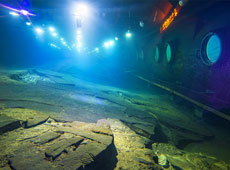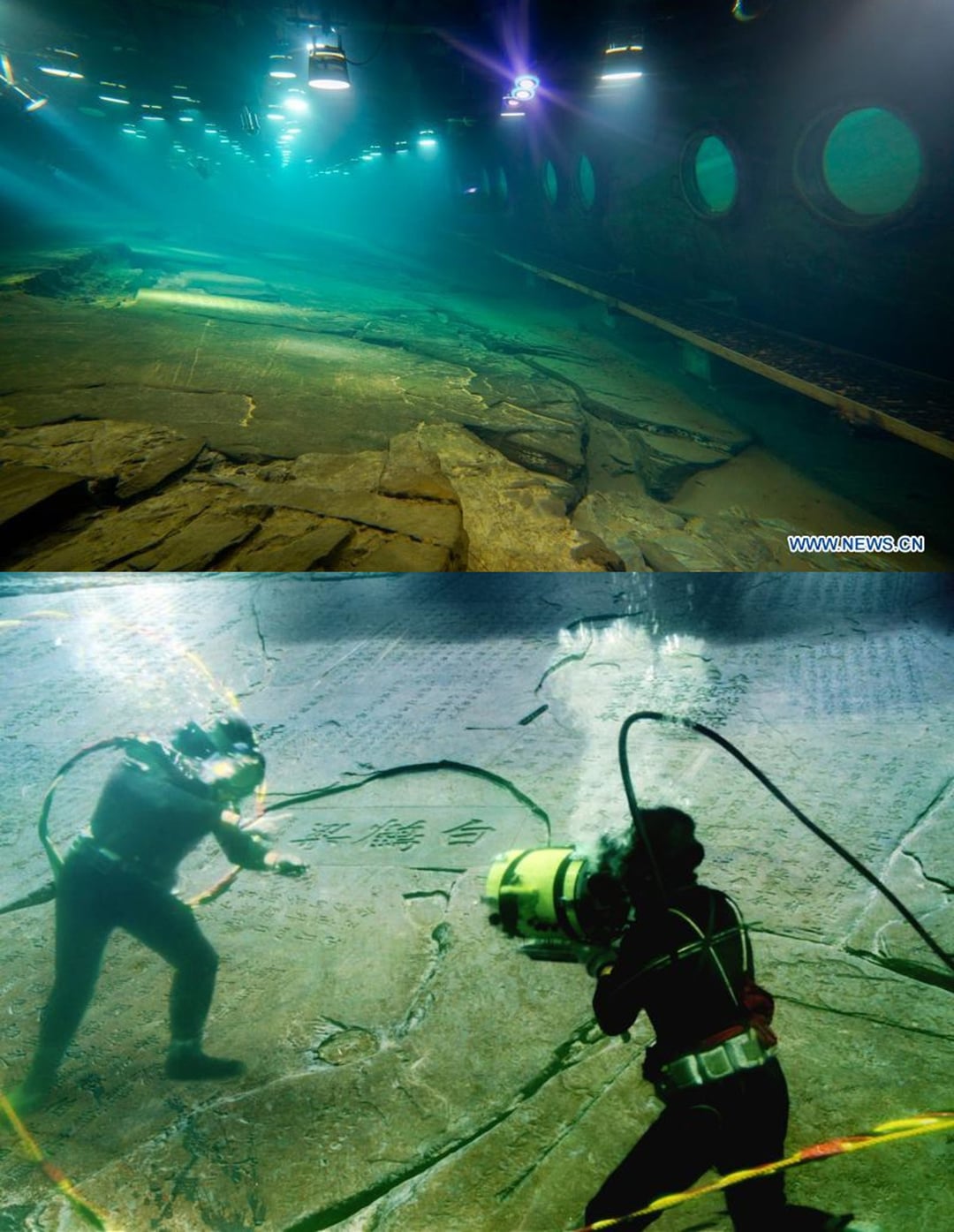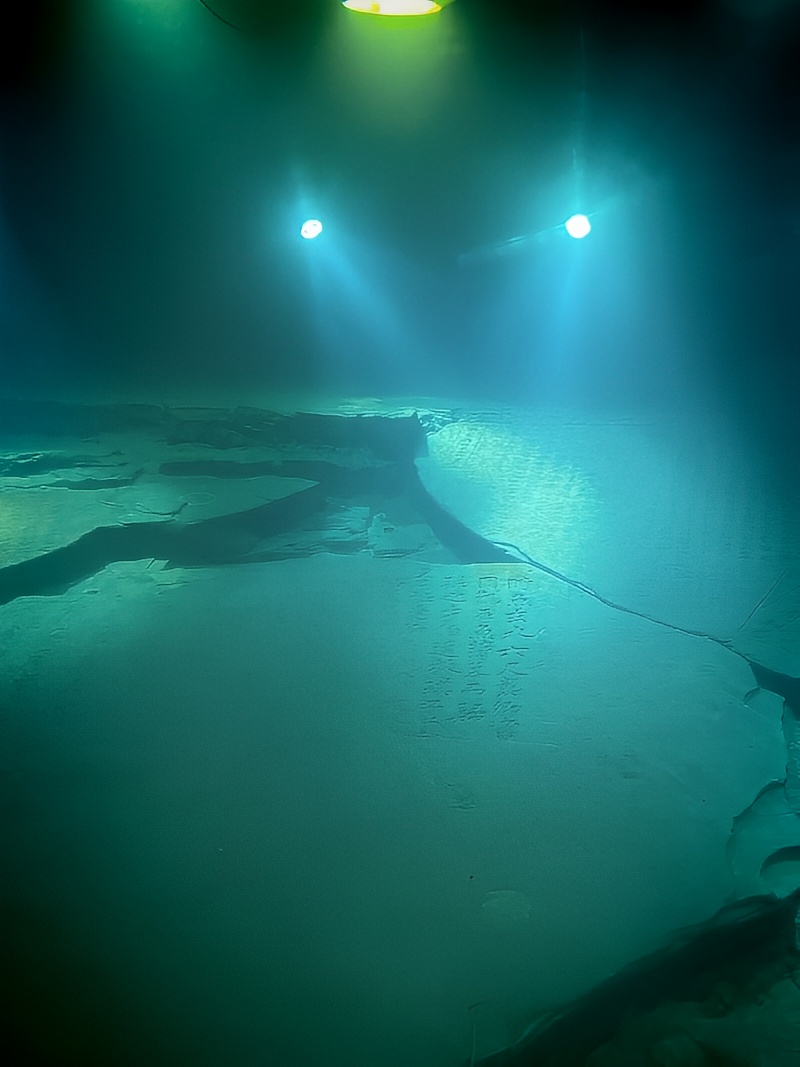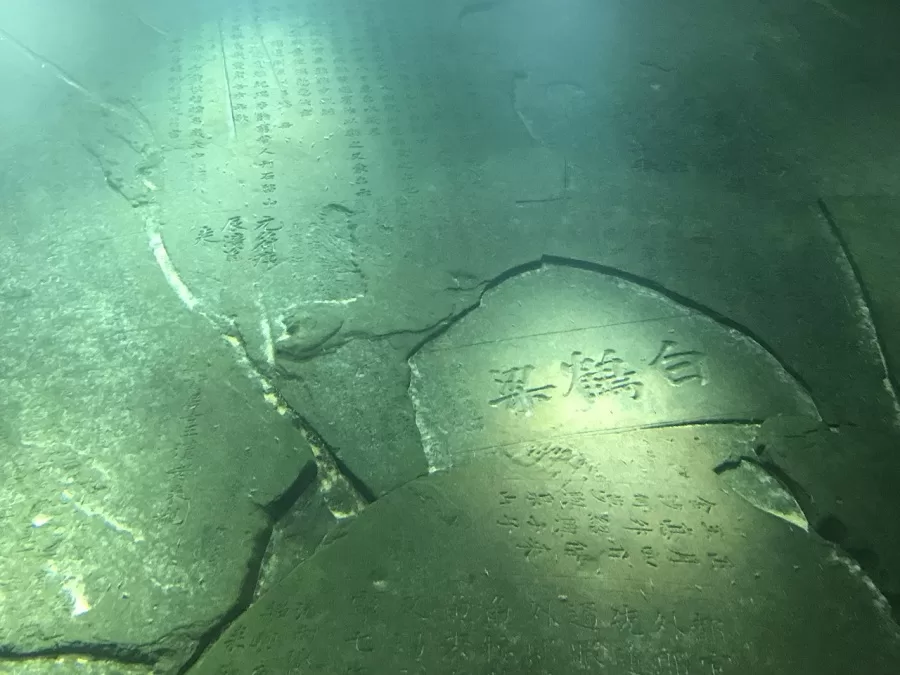The Historic Baiheliang Underwater Inscriptions: A Must-See for History Buffs

An Essential Guide to Visiting Baiheliang_Underwater_Inscriptions
Nestled beneath the waves of the Yangtze River, the Baiheliang Underwater Museum offers a unique glimpse into China’s rich cultural and hydrological heritage. Often referred to as the world’s first ancient hydrological station, this remarkable site showcases over 1,200 years of history through its exquisite underwater inscriptions and carvings. As water levels fluctuate with the seasons, these inscriptions, which include 165 unique carvings and 30,000 characters, narrate tales of the river’s ever-changing dynamics and the civilization that thrived alongside it.
When you visit Baiheliang, you’re not just stepping into a museum; you’re diving into a living history book that tells the story of ancient China’s ingenuity in measuring and recording water levels. The intricate stone fishes carved into the ridge serve as a testament to the remarkable craftsmanship of their creators and stand as a symbol of the region’s cultural legacy. Whether you’re an avid historian, a lover of art, or simply an inquisitive traveler, Baiheliang invites you to explore its depths, where the past and present intertwine beneath the surface.
Prepare to embark on an unforgettable journey as you traverse the underwater exhibition, marveling at the artistry of ancient calligraphy displayed through state-of-the-art observation windows. This essential guide will equip you with everything you need to know for an extraordinary visit to Baiheliang Underwater Inscriptions, ensuring you don’t miss the chance to witness one of the most fascinating archaeological treasures of our time.
In This Guide
- An Essential Guide to Visiting Baiheliang_Underwater_Inscriptions
- The Rich History and Legends of Baiheliang_Underwater_Inscriptions
- Main Highlights: What You Absolutely Can’t Miss
- Planning Your Visit: A Practical Guide
- Tickets: Prices, Booking, and Tips
- How to Get There: A Complete Transportation Guide
- Local Cuisine and Accommodation Nearby
- Frequently Asked Questions
- Final Thoughts on Your Trip
The Rich History and Legends of Baiheliang_Underwater_Inscriptions
Nestled beneath the waters of the Yangtze River lies a remarkable testament to human ingenuity and the passage of time—the Baiheliang Underwater Museum. This unique archaeological site boasts a rich history that dates back over 1,200 years, encapsulating the evolution of hydrological observation through stunning stone inscriptions and carvings.
The story of Baiheliang, or White Crane Ridge, begins in the year 763 AD, when ancient Chinese scholars first began to etch their observations into the natural stone ridge. These inscriptions served a crucial purpose: they recorded the fluctuations in water levels of the Yangtze River, providing invaluable data for navigation and agricultural practices. The ridge itself measures an impressive 1,600 meters in length and about 15 meters in width, making it an extraordinary natural feature.
What sets Baiheliang apart is its innovative method of water level measurement, which involved intricately carved stone fish. These fish, now submerged beneath the surface due to the construction of the Three Gorges Dam, once served as a vivid and practical gauge of the river’s changing tides. The inscriptions, totaling 165 in number and comprising over 30,000 Chinese characters, reflect not just the water levels but also the cultural and artistic expressions of various dynasties, including the Tang, Song, Yuan, Ming, and Qing. This makes Baiheliang a vibrant “forest of steles underwater,” representing a confluence of history, art, and science.
The significance of Baiheliang transcends mere historical interest; it also embodies a deep connection to the surrounding environment and the people who have lived alongside the Yangtze River for centuries. The inscriptions capture the essence of folk culture, showcasing exquisite calligraphy and poetic works that have survived the ravages of time. Notable styles from famous calligraphers such as Yan Zhenqing and Liu Gongquan can be appreciated within these underwater inscriptions, giving visitors a glimpse into the artistry of ancient China.
In 2012, Baiheliang was recognized for its cultural importance and was placed on the World Cultural Heritage tentative list by UNESCO. This acknowledgment highlights the ridge’s role as the first ancient hydrological station in the world, a title it rightfully claims due to its unparalleled contributions to understanding water management and measurement techniques.
Today, the Baiheliang Underwater Museum offers a unique opportunity for visitors to explore this submerged treasure. Advanced technologies have been employed to create an “unstressed container,” allowing guests to view the authentic underwater inscriptions without compromising their integrity. As you traverse the museum, you can admire the inscriptions through observation windows or rotating cameras, immersing yourself in the narrative of a civilization that once thrived along the banks of the Yangtze.
The legends and history of Baiheliang are not just a window into the past; they are a reminder of humanity’s enduring relationship with nature and the importance of preserving our cultural heritage for future generations. As you stand before the inscriptions of Baiheliang, you are not merely observing art; you are connecting with a legacy that has shaped a region and its people for over a millennium.

Baiheliang_Underwater_Inscriptions.
Main Highlights: What You Absolutely Can’t Miss
When visiting the Baiheliang Underwater Museum, there are several captivating highlights that you simply cannot miss. This unique site not only serves as a remarkable archaeological treasure but also offers a journey through China’s rich hydrological history. Here’s what to look out for during your visit:
The Ancient Hydrological Inscriptions
At the heart of Baiheliang’s allure are its ancient hydrological inscriptions, often described as a “forest of steles underwater.” Boasting 165 inscriptions that span over 1,200 years, these ancient carvings chronicle the water level changes of the Yangtze River from the Tang Dynasty all the way to the 1960s. The calligraphy on display showcases various styles, including seal, regular, cursive, and running scripts, as well as techniques from renowned calligraphers like Yan Zhenqing and Liu Gongquan. This artistic cluster not only reflects the cultural richness of China but also serves as a testament to the ingenuity of ancient civilizations in documenting their environment.
The Stone Fish Water Gauges
One of the most exceptional features of Baiheliang is its innovative use of stone fish as water gauges. With 18 meticulously carved stone fish still preserved underwater, these unique sculptures represent the world’s first ancient hydrological station. These carvings were designed to accurately measure water levels in the Yangtze River, allowing ancient communities to track fluctuations. As you explore the museum, pay special attention to the stone fish, particularly one that has an eye aligned with the water level, revealing an incredible feat of ancient engineering.
The Underwater Exhibition Hall
To fully appreciate the inscriptions and artifacts, don’t miss the underwater exhibition hall. Accessible via a 90-meter-long escalator that descends into the depths, the hall features a 70-meter-long viewing gallery with 23 observation windows and 28 rotating cameras. This immersive experience allows you to witness the inscriptions up close as they are illuminated in the water, creating a mesmerizing view of this historical site. The juxtaposition of ancient artistry against the enchanting underwater backdrop is truly a sight to behold.
The Cultural Significance
Baiheliang is not just an archaeological site; it is a living museum of Chinese culture. Many inscriptions contain poems, records, and reflections of the people who lived in harmony with the river. Understanding the cultural context behind these inscriptions offers deeper insights into the relationship between humanity and nature over the centuries.
Tips for Your Visit
- Start at the Exhibition Hall: Begin your exploration on the second floor, where you can find introductory displays about the site’s rich history.
- Take Your Time: The underwater gallery is designed for leisurely exploration, so spend time admiring the intricate details of the inscriptions and stone fish.
- Photography: Be prepared to capture stunning underwater views, as the lighting creates a magical atmosphere for photography enthusiasts.
- Plan Your Arrival: The museum is about 1.5 to 2 hours from downtown Chongqing by car or a 40-minute train ride, followed by a short taxi ride. Ensure you allocate sufficient time to explore.
Baiheliang Underwater Museum is a gem that seamlessly blends history, art, and nature. Whether you are an archaeology enthusiast, a lover of art, or simply someone looking to experience the beauty of China, this unique site promises an unforgettable journey into the depths of time.

Baiheliang_Underwater_Inscriptions.
Planning Your Visit: A Practical Guide
Visiting the Baiheliang Underwater Museum, a remarkable testament to ancient hydrological engineering, can be an unforgettable experience. Nestled in the Fuling District of Chongqing, this unique site not only offers a glimpse into Chinese history but also showcases exquisite stone carvings and inscriptions that have been preserved underwater for centuries. Here’s how to make the most of your visit.
Getting There
Location:
Baiheliang Underwater Museum is situated at No. 185, 2nd Section of Binjiang Avenue, Fuling District, Chongqing (重庆市涪陵区滨江大道二段185号).
Transport Options:
– By Car: It takes about 1.5 to 2 hours to drive approximately 110 km from downtown Chongqing.
– By Train: Consider taking a high-speed train from Chongqing to Fuling North Railway Station, which takes about 40 minutes. From there, a local taxi will take around 30 minutes to reach the museum.
Opening Hours and Admission
Check the official website or contact customer support to confirm the current opening hours and ticket prices, as they may change seasonally or due to special events.
What to Expect
Underwater Gallery:
Upon arrival, take the 90-meter-long escalator that descends at a 40-degree angle into the underwater tunnel. The 70-meter-long visiting gallery allows you to admire the inscriptions and artifacts through 23 observation windows and 28 rotating cameras, providing clear views of this submerged treasure.
Exhibition Hall:
Before heading underwater, visit the exhibition hall on the second floor to learn about the history and significance of Baiheliang. This area features informative displays, pictures, and artifacts, giving context to what you will see in the underwater gallery.
Highlights to Explore
- Ancient Inscriptions:
- Marvel at over 165 inscriptions, comprising more than 30,000 characters, which document water level changes over 1,200 years.
-
Observe the stunning calligraphy and intricate stone carvings that showcase the artistic skills of ancient Chinese cultures.
-
Stone Fishes:
- Discover the 18 carved stone fishes, which served as ancient water gauges. One fish notably marks the water level of the upper Yangtze, illustrating innovative hydrological observation methods.
Tips for a Memorable Visit
- Photography: While you can take photos, be mindful of any restrictions inside the museum, particularly in the underwater sections.
- Timing: Plan your visit during water shortage months if you wish to see more of the site above water.
- Facilities: Check for available amenities such as restrooms and food services. Bringing snacks and water is advisable, as options may be limited.
- Guided Tours: Consider joining a guided tour for deeper insights into the historical significance of the inscriptions and the engineering feats of the ancient civilization.
Contact Information
For inquiries, you can reach the Baiheliang Underwater Museum directly:
- Phone: (+86) 28-85227275 / 28-85223672 / 19138970032
- Email: [email protected]
Conclusion
The Baiheliang Underwater Museum is a unique destination that combines history, culture, and stunning artistry. Whether you’re a history buff, an art enthusiast, or simply a curious traveler, this underwater marvel promises to enrich your understanding of ancient Chinese civilization. Make sure to plan ahead and enjoy your visit to this extraordinary site!

Baiheliang_Underwater_Inscriptions.
Tickets: Prices, Booking, and Tips
When planning your visit to the Baiheliang Underwater Museum, understanding ticket prices, booking options, and some handy tips will enhance your experience.
Ticket Prices
Currently, the admission fees for the Baiheliang Underwater Museum are quite reasonable, ensuring that this unique cultural experience is accessible to a wide range of visitors. As of now, the general ticket price is around CNY 70 (approximately $10 USD), but it’s advisable to check for any updates or potential discounts for students, seniors, or group bookings.
Booking Your Visit
Tickets can be purchased on-site at the museum entrance, but to avoid any long queues, especially during peak tourist seasons, it’s wise to consider booking in advance. You can also inquire about guided tours that may offer additional insights into the rich history and significance of the underwater inscriptions.
For personalized experiences, especially if you’re part of a cruise group, reach out to local travel agencies specializing in Yangtze River excursions. They can assist in arranging tailored visits that incorporate the museum into your itinerary.
Getting There
The Baiheliang Underwater Museum is located approximately 110 km from downtown Chongqing, making it easily accessible either by car or high-speed train. If you opt for the train, you can reach Fuling North Railway Station in about 40 minutes, followed by a short taxi ride of about 30 minutes to the museum.
Tips for Visiting
- Plan Your Timing: The best time to visit is in the early morning or late afternoon to avoid the largest crowds and enjoy a more intimate experience.
- Guided Tours: Consider joining a guided tour for deeper insights into the inscriptions and their historical context.
- Photography: Bring a camera, but be mindful of museum policies regarding photography.
- Explore the Exhibition Hall: Before diving into the underwater section, spend some time in the exhibition hall on the second floor to familiarize yourself with the history and significance of Baiheliang.
- Dress Comfortably: Given that part of the visit involves a descent into the underwater viewing area, wear comfortable shoes and clothing.
By following these tips and planning accordingly, your visit to the Baiheliang Underwater Museum will be both enlightening and memorable. Enjoy your journey into this remarkable blend of history and culture!
How to Get There: A Complete Transportation Guide
Reaching the Baiheliang Underwater Museum, a remarkable archaeological site in Chongqing, is a journey worth undertaking for those captivated by history and culture. Here’s your transportation guide to navigate your way to this unique underwater marvel.
Getting to Baiheliang Underwater Museum
Location Overview:
The Baiheliang Underwater Museum is situated at No. 185, 2nd Section of Binjiang Avenue, Fuling District, Chongqing (重庆市涪陵区滨江大道二段185号). It is approximately 110 kilometers from downtown Chongqing, requiring about 1.5 to 2 hours of travel by car.
By Car
If you prefer the convenience of driving, renting a car is a viable option. The route is straightforward, and you’ll enjoy scenic views along the way. Here’s a quick guide:
– From Chongqing Downtown:
– Take the G50 Huyu Expressway towards Fuling.
– Follow the signs to the museum’s address.
Tip: Consider using a navigation app for real-time traffic updates and the best route suggestions.
By Train
For a faster and more efficient travel experience, taking a high-speed train is highly recommended.
– Train to Fuling:
– Board a high-speed train from Chongqing North Railway Station to Fuling North Railway Station. This journey lasts about 40 minutes.
– Upon arrival at Fuling North, you can take a local taxi or rideshare service to the museum, which will take around 30 minutes.
Train Schedule: It’s advisable to check the latest train schedules in advance, as they can vary.
Local Transportation
Once in Fuling, the most practical way to reach the museum is by taxi or rideshare. Here are a few tips:
– Taxi Services: Taxis are readily available outside the train station. Ensure the driver understands your destination.
– Rideshare Apps: Services like Didi can also be a convenient option, allowing you to book your ride directly from your smartphone.
Additional Considerations
- Timing Your Visit: The museum is best enjoyed during daylight hours, so plan your arrival accordingly.
- Weather Check: Before heading out, check the weather conditions, as they can affect travel times and your overall experience at the museum.
Unique Experiences
While visiting Baiheliang, consider exploring the surrounding area and other attractions in Fuling for a more comprehensive journey. The rich history and cultural significance of the region make it a delightful stop for any traveler.
By following this transportation guide, you’ll be well-equipped to embark on your adventure to the Baiheliang Underwater Museum, where you can immerse yourself in the fascinating history of ancient hydrology.

Baiheliang_Underwater_Inscriptions.
Local Cuisine and Accommodation Nearby
When visiting the Baiheliang Underwater Museum, you’ll find yourself in the picturesque Fuling District of Chongqing, a region rich in culture and culinary delights. After immersing yourself in the ancient hydrological marvel of Baiheliang, treat your taste buds to the local flavors and unwind in nearby accommodations that enhance your experience.
Local Cuisine
-
Fuling Pickled Vegetables (涪陵榨菜)
A must-try when in the Fuling area, these pickled vegetables are renowned across China. The crunchy texture and savory taste make them a perfect accompaniment to rice or noodles. Many local restaurants serve them as a side dish or a topping, adding a delightful zest to your meal. -
Spicy Hot Pot (火锅)
Chongqing is famous for its spicy hot pot, and Fuling is no exception. Dive into a bubbling pot of broth filled with an array of ingredients, including meats, vegetables, and tofu. The heat is balanced with fragrant spices, creating a memorable dining experience. Popular spots include Haidilao Hot Pot and Chuan Wei Dao, both known for their fresh ingredients and vibrant atmosphere. -
Baiheliang Fish (白鹤梁鱼)
For something truly local, sample the Baiheliang fish, often prepared with aromatic spices and served in a variety of styles, from grilled to steamed. Many restaurants near the museum serve this dish, ensuring you experience the flavors of the Yangtze River firsthand. -
Noodle Dishes
Fuling is also known for its delightful noodle dishes, including the popular Spicy Beef Noodles and Sour Rice Noodles. These hearty meals are not only filling but provide a taste of authentic regional flavors.
Accommodation Nearby
-
Fuling Hotel (涪陵宾馆)
Conveniently located just a short drive from the Baiheliang Underwater Museum, the Fuling Hotel offers comfortable rooms and modern amenities. Guests can enjoy a restaurant on-site that serves local cuisine, making it a great base for exploring the area. -
Chongqing Fuling Longteng Hotel (重庆涪陵龙腾酒店)
This hotel provides a welcoming atmosphere with spacious rooms and a friendly staff. Its proximity to the museum and local eateries makes it a practical choice for travelers looking to explore Fuling. -
Hanting Hotel Fuling (汉庭酒店)
A budget-friendly option, Hanting Hotel offers clean, comfortable accommodations and is ideal for travelers looking to save while still enjoying a convenient location. The hotel is nearby major transport links, making it easy to access the museum and other attractions. -
Greentree Inn Chongqing Fuling (格林豪泰重庆涪陵酒店)
Known for its affordability and comfort, this hotel provides a cozy stay with essential amenities and is situated close to local dining options. It’s perfect for visitors who want to explore the cultural richness of the area without breaking the bank.
Final Thoughts
After a day of exploring the underwater wonders of Baiheliang, indulge in the local culinary scene and find respite in comfortable accommodations nearby. This combination guarantees a fulfilling experience that encompasses the rich history and vibrant culture of Fuling District. Enjoy your journey!

Baiheliang_Underwater_Inscriptions.
Frequently Asked Questions
-
What is the Baiheliang Underwater Museum?
The Baiheliang Underwater Museum, also known as the White Crane Ridge Underwater Museum, is a unique archaeological site located in Chongqing, China. It features ancient hydrological inscriptions and stone carvings that date back over 1,200 years, making it the world’s first underwater museum dedicated to hydrological history. -
How do I get to the Baiheliang Underwater Museum from downtown Chongqing?
The museum is approximately 110 kilometers from downtown Chongqing. You can take a taxi for a 1.5 to 2-hour drive, or opt for a high-speed train to Fuling North Railway Station (about 40 minutes), followed by a 30-minute taxi ride to the museum. -
What are the main attractions within the museum?
Visitors can explore over 165 ancient inscriptions, including 18 carved stone fishes that served as water gauges. The highlight is the underwater observation gallery, where you can admire the exquisite calligraphy and intricate carvings that illustrate the historical changes in the Yangtze River’s water levels. -
What are the visiting hours for the Baiheliang Underwater Museum?
The museum generally operates from 9 AM to 5 PM, but it’s advisable to check their official website or contact them for the latest information on opening hours and any potential changes. -
Is there an entrance fee to visit the museum?
Yes, there is an entrance fee for the Baiheliang Underwater Museum. The fee may vary, so it’s best to check in advance or inquire on-site for current pricing. -
Are there guided tours available at the museum?
Yes, guided tours are often available, providing visitors with in-depth information about the historical significance of the inscriptions and the methods used for their preservation. It’s recommended to book a guided tour in advance to enhance your experience. -
Can I visit the museum as part of a Yangtze River cruise excursion?
Currently, most Yangtze River cruises do not include a visit to the Baiheliang Underwater Museum as part of their itineraries. However, you can arrange a personalized trip to include this incredible site. Contact a travel expert for assistance in planning your visit. -
What should I wear when visiting the museum?
Comfortable clothing and shoes are recommended, as you may be walking and standing for extended periods. If you plan to explore the underwater observation area, consider wearing layers, as it can be cooler in that environment.
Final Thoughts on Your Trip
As you reflect on your visit to the Baiheliang Underwater Museum, allow the echoes of history to wash over you like the gentle currents of the Yangtze River. Standing before the remarkable inscriptions and intricate stone carvings, you’ve journeyed not just through time, but through the very essence of ancient Chinese culture. This underwater treasure, a unique fusion of art, science, and history, tells a story of human ingenuity and resilience that spans over 1,200 years.
As you depart, take with you the inspiration of those who meticulously carved their observations into stone, creating a legacy that continues to fascinate and educate. Whether you admired the delicate artistry of calligraphy or marveled at the innovative water gauges, your experience at Baiheliang is a reminder of the power of preservation and the beauty of cultural heritage.
Let this remarkable site be a highlight in your travels, encouraging you to seek out the stories that lie beneath the surface in every destination you visit. Until your next adventure, may the memories of Baiheliang linger in your heart, inspiring future explorations of the world’s wonders.